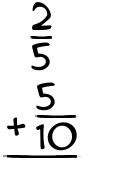What is 2/5 + 5/10?

|
Let's add
|
|||||||||||
Step 1Our denominators (bottom numbers) don't match, so we can't add yet. Since 5 is evenly divided by 10, we can multiply just one term to get a common denominator. Multiply 2 by 2, and get 4, then we multiply 5 by 2 and get 10. The problem now has new fractions to add:
|
|||||||||||
Step 2Since our denominators match, we can add the numerators. 4 + 5 = 9 The sum we get is
|
|||||||||||
Step 3The last step is to reduce the fraction if we can. To find out, we try dividing it by 2... Nope. Try the next prime number, 3... Nope. Try the next prime number, 5... Nope. Try the next prime number, 7... Nope. Try the next prime number, 11... No good. 11 is larger than 9. So we're done reducing. Congratulations! Here's your final answer to 2/5 + 5/10
|
© 2014 Randy Tayler